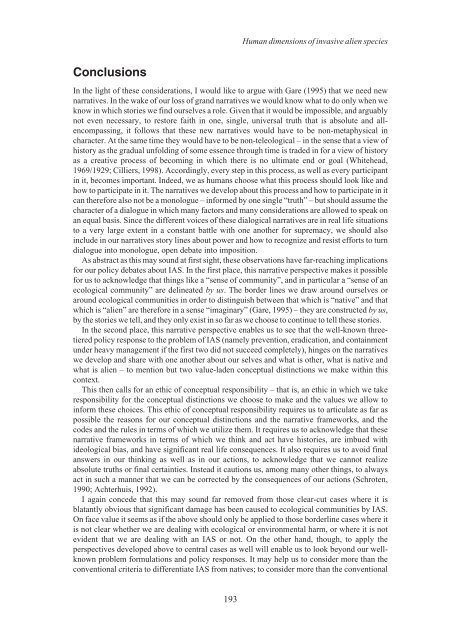Alien Species.vp - IUCN
Alien Species.vp - IUCN
Alien Species.vp - IUCN
You also want an ePaper? Increase the reach of your titles
YUMPU automatically turns print PDFs into web optimized ePapers that Google loves.
Conclusions<br />
In the light of these considerations, I would like to argue with Gare (1995) that we need new<br />
narratives. In the wake of our loss of grand narratives we would know what to do only when we<br />
know in which stories we find ourselves a role. Given that it would be impossible, and arguably<br />
not even necessary, to restore faith in one, single, universal truth that is absolute and allencompassing,<br />
it follows that these new narratives would have to be non-metaphysical in<br />
character. At the same time they would have to be non-teleological – in the sense that a view of<br />
history as the gradual unfolding of some essence through time is traded in for a view of history<br />
as a creative process of becoming in which there is no ultimate end or goal (Whitehead,<br />
1969/1929; Cilliers, 1998). Accordingly, every step in this process, as well as every participant<br />
in it, becomes important. Indeed, we as humans choose what this process should look like and<br />
how to participate in it. The narratives we develop about this process and how to participate in it<br />
can therefore also not be a monologue – informed by one single “truth” – but should assume the<br />
character of a dialogue in which many factors and many considerations are allowed to speak on<br />
an equal basis. Since the different voices of these dialogical narratives are in real life situations<br />
to a very large extent in a constant battle with one another for supremacy, we should also<br />
include in our narratives story lines about power and how to recognize and resist efforts to turn<br />
dialogue into monologue, open debate into imposition.<br />
As abstract as this may sound at first sight, these observations have far-reaching implications<br />
for our policy debates about IAS. In the first place, this narrative perspective makes it possible<br />
for us to acknowledge that things like a “sense of community”, and in particular a “sense of an<br />
ecological community” are delineated by us. The border lines we draw around ourselves or<br />
around ecological communities in order to distinguish between that which is “native” and that<br />
which is “alien” are therefore in a sense “imaginary” (Gare, 1995) – they are constructed by us,<br />
by the stories we tell, and they only exist in so far as we choose to continue to tell these stories.<br />
In the second place, this narrative perspective enables us to see that the well-known threetiered<br />
policy response to the problem of IAS (namely prevention, eradication, and containment<br />
under heavy management if the first two did not succeed completely), hinges on the narratives<br />
we develop and share with one another about our selves and what is other, what is native and<br />
what is alien – to mention but two value-laden conceptual distinctions we make within this<br />
context.<br />
This then calls for an ethic of conceptual responsibility – that is, an ethic in which we take<br />
responsibility for the conceptual distinctions we choose to make and the values we allow to<br />
inform these choices. This ethic of conceptual responsibility requires us to articulate as far as<br />
possible the reasons for our conceptual distinctions and the narrative frameworks, and the<br />
codes and the rules in terms of which we utilize them. It requires us to acknowledge that these<br />
narrative frameworks in terms of which we think and act have histories, are imbued with<br />
ideological bias, and have significant real life consequences. It also requires us to avoid final<br />
answers in our thinking as well as in our actions, to acknowledge that we cannot realize<br />
absolute truths or final certainties. Instead it cautions us, among many other things, to always<br />
act in such a manner that we can be corrected by the consequences of our actions (Schroten,<br />
1990; Achterhuis, 1992).<br />
I again concede that this may sound far removed from those clear-cut cases where it is<br />
blatantly obvious that significant damage has been caused to ecological communities by IAS.<br />
On face value it seems as if the above should only be applied to those borderline cases where it<br />
is not clear whether we are dealing with ecological or environmental harm, or where it is not<br />
evident that we are dealing with an IAS or not. On the other hand, though, to apply the<br />
perspectives developed above to central cases as well will enable us to look beyond our wellknown<br />
problem formulations and policy responses. It may help us to consider more than the<br />
conventional criteria to differentiate IAS from natives; to consider more than the conventional<br />
193<br />
Human dimensions of invasive alien species












